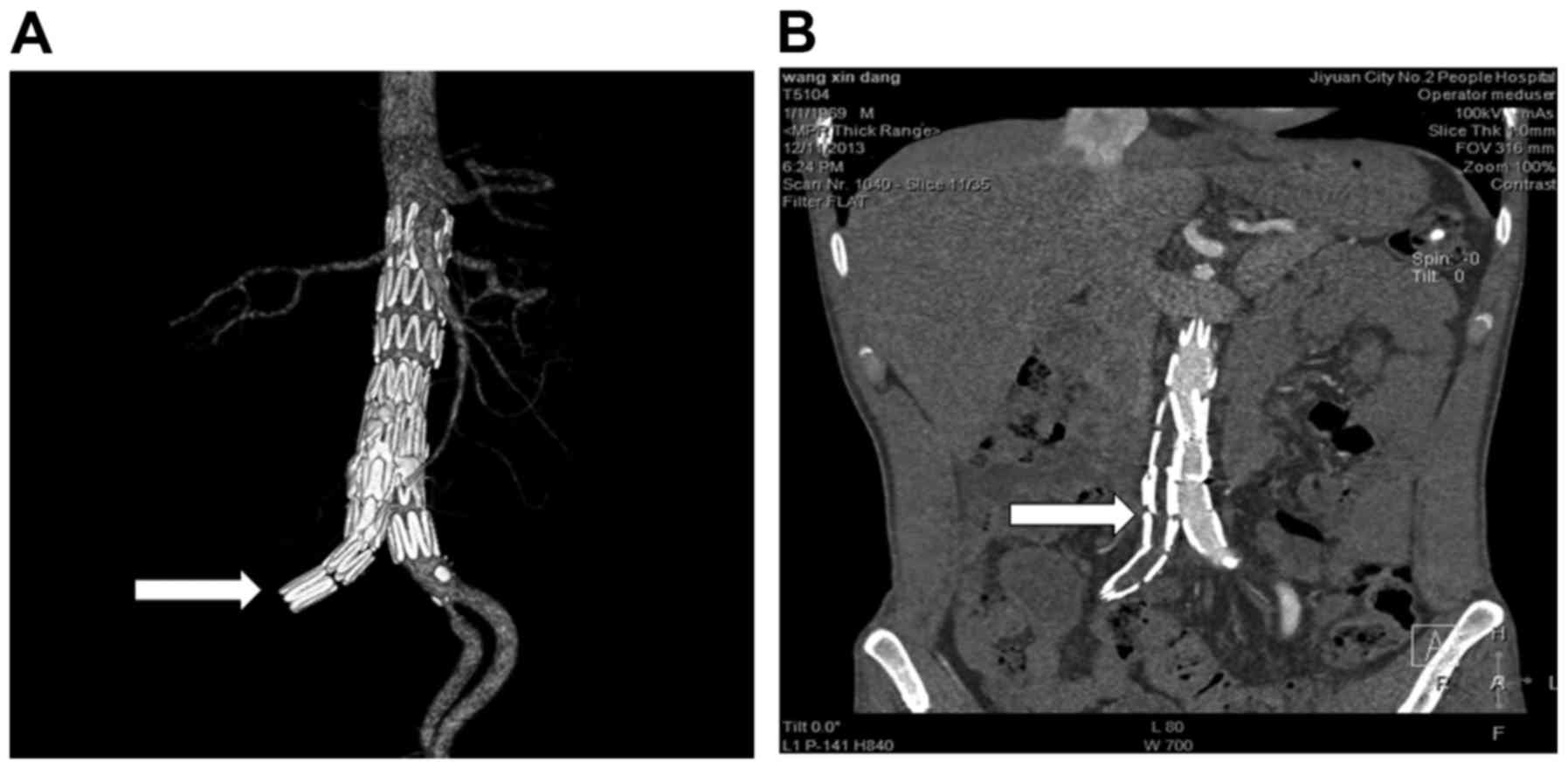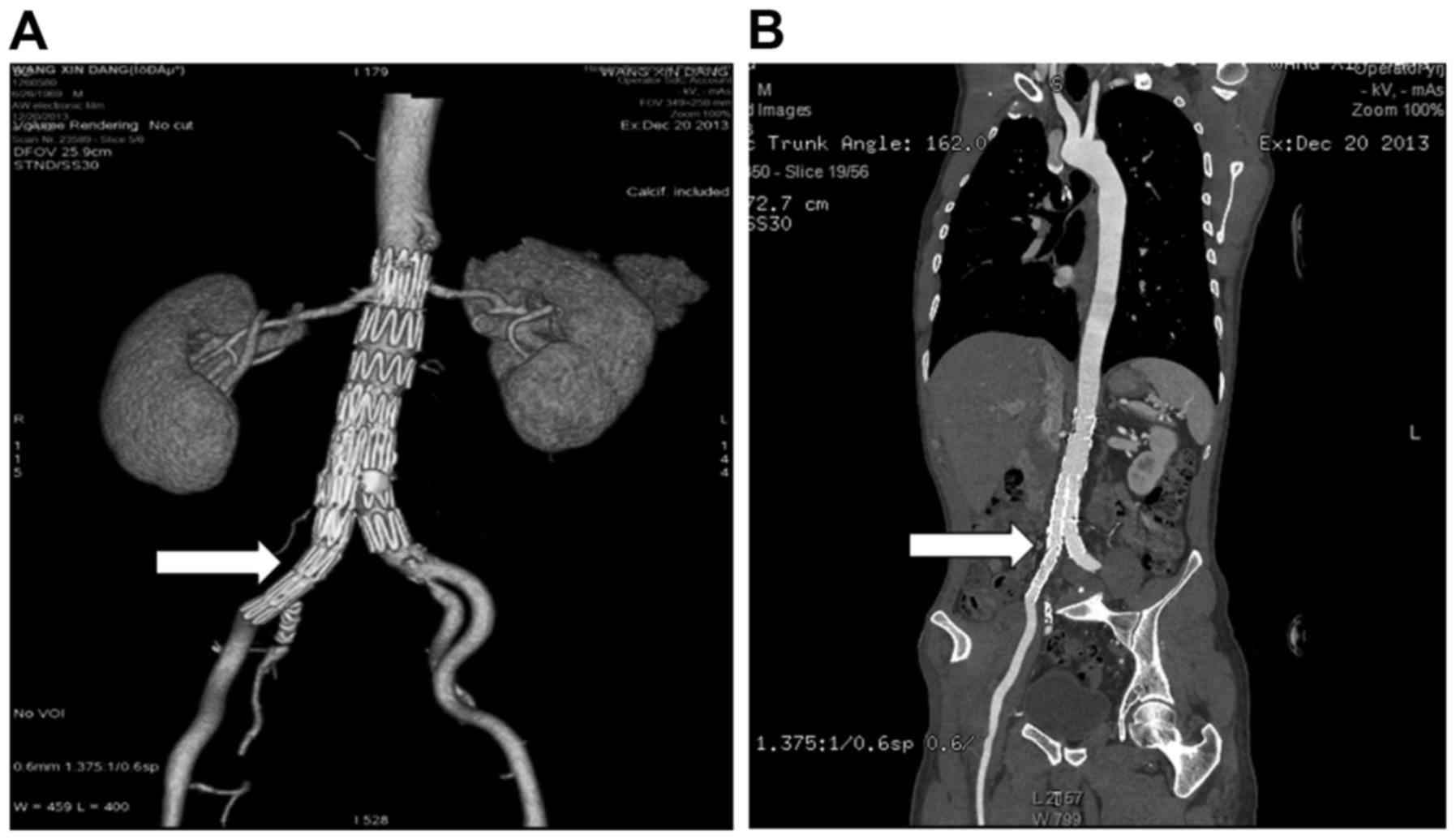|
1
|
Scali ST, Feezor RJ, Huber TS and Beck AW:
Acute bilateral renal artery chimney stent thrombosis after
endovascular repair of a juxtarenal abdominal aortic aneurysm. J
Vasc Surg. 61:1058–1061. 2015. View Article : Google Scholar : PubMed/NCBI
|
|
2
|
Lim S, Halandras PM, Park T, Lee Y,
Crisostomo P, Hershberger R, Aulivola B and Cho JS: Outcomes of
endovascular abdominal aortic aneurysm repair in high-risk
patients. J Vasc Surg. 61:862–868. 2015. View Article : Google Scholar : PubMed/NCBI
|
|
3
|
Wang Y, Joannic D, Delassus P, Lalande A,
Juillion P and Fontaine JF: Comparison of the strain field of
abdominal aortic aneurysm measured by magnetic resonance imaging
and stereovision: A feasibility study for prediction of the risk of
rupture of aortic abdominal aneurysm. J Biomech. 48:1158–1164.
2015. View Article : Google Scholar : PubMed/NCBI
|
|
4
|
Törnqvist P, Dias N, Sonesson B,
Kristmundsson T and Resch T: Intra-operative cone beam computed
tomography can help avoid reinterventions and reduce CT follow up
after infrarenal EVAR. Eur J Vasc Endovasc Surg. 49:390–395. 2015.
View Article : Google Scholar : PubMed/NCBI
|
|
5
|
Troisi N and Torsello G: Commentary:
New-generation devices and adjunctive procedures are the key
elements to expanding the indications for endovascular aneurysm
repair. J Endovasc Ther. 22:179–181. 2015. View Article : Google Scholar : PubMed/NCBI
|
|
6
|
You JH, Park CB, Park HK, Jin ES and Kim
CJ: Endovascular repair of graft limb occlusion after endovascular
repair for abdominal aortic aneurysm using 0.014-inch guidewire and
coronary balloon. Int J Cardiol. 153:e37–e38. 2011. View Article : Google Scholar : PubMed/NCBI
|
|
7
|
Alder L, Al-Jarrah Q, Rahi MA, Wilde N and
Al-Khaffaf H: Percutaneous catheter-directed thrombolysis for
treatment of complete body and bilateral limb endovascular aortic
graft occlusion. EJVES Extra. 24:e37–e38. 2012. View Article : Google Scholar
|
|
8
|
Liaw JV, Clark M, Gibbs R, Jenkins M,
Cheshire N and Hamady M: Update: Complications and management of
infrarenal EVAR. Eur J Radiol. 71:541–551. 2009. View Article : Google Scholar : PubMed/NCBI
|
|
9
|
Woody JD and Makaroun MS: Endovascular
graft limb occlusion. Semin Vasc Surg. 17:262–267. 2004. View Article : Google Scholar : PubMed/NCBI
|
|
10
|
Sivamurthy N, Schneider DB, Reilly LM,
Rapp JH, Skovobogatyy H and Chuter TA: Adjunctive primary stenting
of Zenith endograft limbs during endovascular abdominal aortic
aneurysm repair: Implications for limb patency. J Vasc Surg.
43:662–670. 2006. View Article : Google Scholar : PubMed/NCBI
|
|
11
|
Cochennec F, Becquemin JP, Desgranges P,
Allaire E, Kobeiter H and Roudot-Thoraval F: Limb graft occlusion
following EVAR: Clinical pattern, outcomes and predictive factors
of occurrence. Eur J Vasc Endovasc Surg. 34:59–65. 2007. View Article : Google Scholar : PubMed/NCBI
|
|
12
|
Carpenter JP, Anderson WN, Brewster DC,
Kwolek C, Makaroun M, Martin J, McCann R, McKinsey J and Beebe HG:
Lifepath Investigators: Multicenter pivotal trial results of the
Lifepath System for endovascular aortic aneurysm repair. J Vasc
Surg. 39:34–43. 2004. View Article : Google Scholar : PubMed/NCBI
|
|
13
|
Erzurum VZ, Sampram ES, Sarac TP, Lyden
SP, Clair DG, Greenberg RK, Ohara PJ, Kashyap VS and Ouriel K:
Initial management and outcome of aortic endograft limb occlusion.
J Vasc Surg. 40:419–423. 2004. View Article : Google Scholar : PubMed/NCBI
|
|
14
|
Becquemin JP, Kelley L, Zubilewicz T,
Desgranges P, Lapeyre M and Kobeiter H: Outcomes of secondary
interventions after abdominal aortic aneurysm endovascular repair.
J Vasc Surg. 39:298–305. 2004. View Article : Google Scholar : PubMed/NCBI
|
|
15
|
Wales L, Dunckley M, Bohm N, Kwok T,
Bratby M, Morgan R, Thompson M and Loftus I: Device-specific
outcomes following endovascular aortic aneurysm repair. Eur J Vasc
Endovasc Surg. 36:661–667. 2008. View Article : Google Scholar : PubMed/NCBI
|
|
16
|
Maldonado TS, Rockman CB, Riles E, Douglas
D, Adelman MA, Jacobowitz GR, Gagne PJ, Nalbandian MN, Cayne NS,
Lamparello PJ, et al: Ischemic complications after endovascular
abdominal aortic aneurysm repair. J Vasc Surg. 40:703–710. 2004.
View Article : Google Scholar : PubMed/NCBI
|
|
17
|
Becquemin JP, Allaire E, Desgranges P and
Kobeiter H: Delayed complications following EVAR. Tech Vasc Interv
Radiol. 8:30–40. 2005. View Article : Google Scholar : PubMed/NCBI
|














